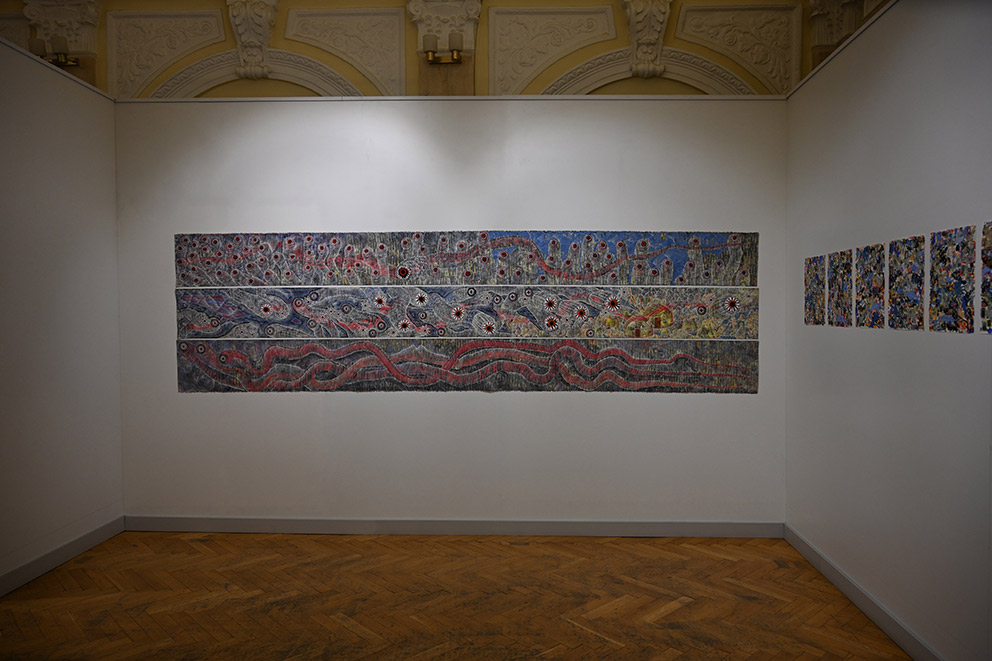


...OtGO este puternic ancorat în tradițiile plaiului natal, locului de unde pornește călătoria sa artistică, atât spirituală, cât și fizică. Tripticul Viermele din deșertul Gobi (Олгой хорхой), expus în cadrul expoziției de față, este inspirat din cultura mongolă, mai cu seamă din folclorul local, care îl descrie având înfățișarea unui vierme uriaș care aduce moarte oamenilor, dar și animalelor. Din legende mai aflăm că locul său de trai este în deșert, acesta aflându-se departe de oameni, constituind pentru ei un pericol doar în cazul invadării arealului său de trai. În relatările mitologice viermele din Gobi este descris drept un duh apărător al deșertului, menirea căruia este de a reaminti constant oamenilor că natura nu le aparține în exclusivitate lor. Aceasta este o forță supremă care necesită a fi respectată, omul fiind obligat să învețe să trăiască în armonie și pace cu toate creaturile sale. Pentru a evita mânia viermelui uriaș, șamanii mongoli efectuau anumite ritualuri speciale, cum ar fi aducerea ofrandelor (mâncare, apă, argint) în locurile unde se credea că trăiește viermele, dar și rostirea cântărilor șamanice pentru a liniști spiritul și a-i cere protecție în timpul călătoriei prin deșert.
În opera sa artistul reușește să reproducă caracterul neliniștit al vietății deșertului prin intermediul liniei și a tehnicii Thangka. Fiecare linie, din care se constituie în cele din urmă corpul viermelui, își are caracterul său, este independentă, irepetabilă, aceste fiind, de altfel, și caracteristicile întregii opere a lui Otgonbayar Ershuu...
...OtGO is deeply rooted in the traditions of his homeland, the place from which his artistic journey — both spiritual and physical — begins. The triptych The Worm of the Gobi Desert (Олгой хорхой), displayed in the current exhibition, is inspired from Mongolian culture, particularly local folklore, which depicts it as a giant worm that brings death to humans and animals. According to the legends, its dwelling is in the desert, far from people, posing a threat only if its territory is invaded. In mythological descriptions, the Gobi worm is considered a guardian spirit of the desert, whose purpose is to constantly remind humans that nature does not belong to them exclusively. It represents a supreme force that must be respected, and humans are obliged to learn to live in harmony and peace with all its creatures. To avoid the wrath of the giant worm, Mongolian shamans performed special rituals, such as offering food, water, or silver coins at the places believed to be the worm’s dwelling, and reciting shamanic chants to soothe its spirit and seek protection during journeys through the desert.
In this artwork, the artist brings to life the restless energy of the desert creature through the use of line and the Thangka technique. Each line forming the worm’s body carries its own unique character, is independent and unique — qualities that define all of Otgonbayar Ershuu’s creations...

NATIONAL ART MUSEUM OF MOLDOVA OtGO Solo Show ‚Cabinet of Curiosities‘ Triptych: The Worm of the Gobi Desert by OtGO 2025, acryl on canvas about 100 x 400 cm, each (about) 33 x 400 cm
The Mongolian death worm (Mongolian: олгой-хорхой, olgoi-khorkhoi, "large intestine-worm") is a creature alleged to exist in the Gobi Desert. Investigations into the legendary creature have been pursued by amateur cryptozoologists and credited academics alike, but there has been little evidence found to support its existence. It can be considered a Cryptid or a mythological animal.
Tales of the creature first came to Western attention as a result of Roy Chapman Andrews's 1926 book On the Trail of Ancient Man. The American paleontologist described second-hand tales of the monster that he heard at a gathering of Mongolian officials: "None of those present ever had seen the creature, but they all firmly believed in its existence and described it minutely.
In 1983, a specimen of Tartar sand boa (Eryx tataricus) was shown to locals who claimed to have seen "olgoi-khorkhoi" and they confirmed that this was the same animal.
